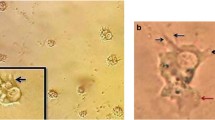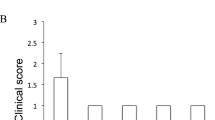Abstract
Acanthamoeba keratitis is a painful corneal infection and difficult to treat because no sufficiently efficient drug has yet been available. The aim of the study therefore was to assess the therapeutic potential of miltefosine on Acanthamoeba keratitis-infected hamster eyes. The cornea of hamsters were infected with Acanthamoeba hatchetti, a human corneal isolate. On the fifth day, all the cornea were microscopically examined in order to determine the degree of infections (G, from 0 to 3). Four groups were then prepared: miltefosine (160 μM); 0.1% propamidine isetionate plus 0.02% polyhexnide; infected control (0.05% ethanol in PBS) and a non-infected control (0.05% ethanol in PBS) groups. The treatment was continued for 28 days. After the treatment, the cornea were excised and used for Acanthamoeba culture to investigate the presence of Acanthamoeba growth. Miltefosine treatment yielded much higher cure scores than propamidine isetionate plus polyhexanide. On the last day of treatment, 85% of the miltefosine-treated eyes were graded as G0; no changes were observed in the uninfected control group eyes; G3 eyes showed only a partial improvement. Furthermore, no Acanthamoeba cells could be recovered from the miltefosine-treated eye samples. Miltefosine appeared to hold necessary therapeutic properties for the treatment of Acanthamoeba keratitis.



Similar content being viewed by others
References
Aichelburg AC, Walochnik J, Assadian O, Prosch H, Steuer A, Perneczky G, Visvesvara GS, Aspöck H, Vetter N (2008) Successful treatment of disseminated Acanthamoeba sp. infection with miltefosine. Emerg Infect Dis 14:1743–1746
Blaha C, Duchêne M, Aspöck H, Walochnik J (2006) In vitro activity of hexadecylphosphocholine (miltefosine) against metronidazole-resistant and -susceptible strains of Trichomonas vaginalis. J Antimicrob Chemother 57:273–278
Chong EM, Dana MR (2007) Acanthamoeba keratitis. Int Ophthalmol Clin 47:33–46
Claerhout I, Goegebuer A, Van Den Broecke C, Kestelyn P (2004) Delay in diagnosis and outcome of Acanthamoeba keratitis. Graefes Arch Clin Exp Ophthalmol 242:648–653
Eibl H, Unger C (1990) Hexadecylphosphocholine: a new and selective antitumor drug. Cancer Treat Rev 17:233–242
Elder MJ, Kilvington S, Dart JKG (1994) A clinicopathologic study of in vitro sensitivity testing and Acanthamoeba keratitis. Invest Ophthalmol Vis Sci 35:1059–1064
Ficker L, Hunter P, Seal D, Wright P (1989) Acanthamoeba keratitis occurring with disposable contact lens wear. Am J Ophthalmol 108:453
Ficker L, Seal D, Warhurst D, Wright P (1990) Acanthamoeba keratitis—resistance to medical therapy. Eye 4:835–838
Khandpur S, Chaturvedi P, Kumar U, Khaitan BK, Samantaray JC, Sharma VK (2010) Oral miltefosine in post-kala-azar dermal leishmaniasis—experience in three cases. Int J Dermatol 49:565–569
Kumar R, Lloyd D (2002) Recent advances in the treatment of Acanthamoeba keratitis. Clin Infect Dis 35:434–441
Lee JE, Oum BS, Choi HY, Yu HS, Lee JS (2007) Cysticidal effect on Acanthamoeba and toxicity on human keratocytes by polyhexamethylene biguanide and chlorhexidine. Cornea 26:736–741
Lorenzo-Morales J, Martínez-Carretero E, Batista N, Alvarez-Marín J, Bahaya Y, Walochnik J, Valladares B (2007) Early diagnosis of amoebic keratitis due to a mixed infection with Acanthamoeba and Hartmannella. Parasitol Res 102:167–169
Marciano-Cabral F, Cabral G (2003) Acanthamoeba spp. as agents of disease in humans. Clin Microbiol Rev 16:273–307
McBride J, Ingram PR, Henriquez FL, Roberts CW (2005) Development of colorimetric microtiter plate assay for assessment of antimicrobials against Acanthamoeba. J Clin Microbiol 43:629–634
Pens CJ, Costa M, Fadanelli C, Caumo K, Rott M (2008) Acanthamoeba spp. and bacterial contamination in contact lens storage cases and the relationship to user profiles. Parasitol Res 103:1241–1245
Polat ZA, Ozcelik S, Vural A, Cetin A (2007) Clinical and histologic evaluations of experimental Acanthamoeba keratitis. Parasitol Res 101:1621–1625
Reinhard T, Sundmacher R (2000) Clinical aspects and therapy of Acanthamoeba keratitis. Ophthalmologe 97:446–459
Santa-Rita RM, Santos Barbosa H, Meirelles MN, de Castro SL (2000) Effect of the alkyllysophospholipids on the proliferation and differentiation of Trypanosoma cruzi. Acta Trop 75:219–228
Scheid P, Zöller L, Pressmar S, Richard G, Michel R (2008) An extraordinary endocytobiont in Acanthamoeba sp. isolated from a patient with keratitis. Parasitol Res 102:945–950
Schuster FL (2002) Cultivation of pathogenic and opportunistic free-living amebas. Clin Microbiol Rev 15:342–354
Seal D (2003) Treatment of Acanthamoeba keratitis. Expert Rev Anti Infect Ther 1:205–208
Seifert K, Duchêne M, Wernsdorfer WH, Kollaritsch H, Scheiner O, Wiedermann G, Hottkowitz T, Eibl H (2001) Effects of miltefosine and other alkylphosphocholines on human intestinal parasite Entamoeba histolytica. Antimicrob Agents Chemother 45:1505–1510
Singhal T, Bajpai A, Kalra V, Kabra SK, Samantaray JC, Satpathy G, Gupta AK (2001) Successful treatment of disseminated Acanthamoeba infection in an immunocompromised patient. Pediatr Infect Dis J 20:623–627
Tseng SH, Lin SC, Chen FK (1998) Is polyhexamethylene biguanide alone effective for Acanthamoeba keratitis? Cornea 7:345–347
Varga JH, Wolf TC, Jensen HG, Parmley VC, Rowsey JJ (1993) Combined treatment of Acanthamoeba keratitis with propamidine, neomycin, and polyhexamethylene biguanide. Am J Ophthalmol 115:466–470
Verma NK, Dey CS (2004) Possible mechanism of miltefosine-mediated death of Leishmania donovani. Antimicrob Agents Chemother 48:3010–3015
Visvesvara GS, Moura H, Schuster FL (2007) Pathogenic and opportunistic free-living amoebae: Acanthamoeba spp., Balamuthia mandrillaris, Naegleria fowleri, and Sappinia diploidea. FEMS Immunol Med Microbiol 50:1–26
Walochnik J, Duchêne M, Seifert K, Obwaller A, Hottkowitz T, Wiedermann G, Eibl H, Aspöck H (2002) Cytotoxic activities of alkylphosphocholines against clinical isolates of Acanthamoeba spp. Antimicrob Agents Chemother 46:695–701
Walochnik J, Obwaller A, Aspock H (2000) Correlations between morphological, molecular biological, and physiological characteristics in clinical and nonclinical isolates of Acanthamoeba spp. Appl Environ Microbiol 66:4408–4413
Walochnik J, Obwaller A, Gruber F, Mildner M, Tschachler E, Suchomel M, Duchêne M, Auer H (2009) Anti-Acanthamoeba efficacy and toxicity of miltefosine in an organotypic skin equivalent. J Antimicrob Chemother 64:539–545
Acknowledgements
This work was supported by Orphanidis Pharma Research GmbH, Wilhelminenstr. 91/IIf, 1160 Vienna, Austria. The authors also thank Prof. Ali Fazil Yenidünya for his invaluable contribution in the preparation of the manuscript.
Author information
Authors and Affiliations
Corresponding author
Rights and permissions
About this article
Cite this article
Polat, Z.A., Obwaller, A., Vural, A. et al. Efficacy of miltefosine for topical treatment of Acanthamoeba keratitis in Syrian hamsters. Parasitol Res 110, 515–520 (2012). https://doi.org/10.1007/s00436-011-2515-0
Received:
Accepted:
Published:
Issue Date:
DOI: https://doi.org/10.1007/s00436-011-2515-0




